From internal pipelines, drains are transported by external ...

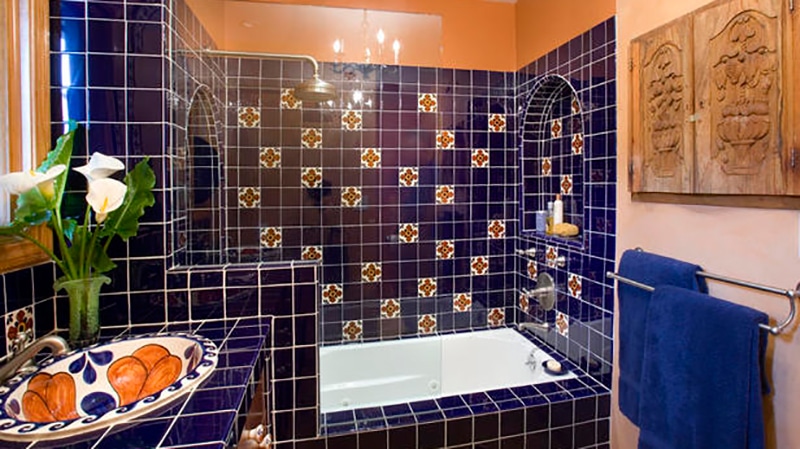
Why do we like beautiful things? After all, a small addition to the interior can dramatically change the general idea of \u200b\u200bthe room. It is pleasant to be in a room where every thing is in its place and harmoniously combines with other objects. Man is so arranged that he perceives the whole picture of the world as a whole, initially without thinking about the details.
When it comes to designing a bathroom, specialists are faced with the task of combining the functional and emotional parts of the issue. Each item must meet the basic requirements:
Modern developments in construction meet all of the above requirements, and with the right approach will help create an individual and perfect interior.
From the whole variety of building materials, there are several types that behave well:
PVC wall paneling
We are talking about popular coatings, which include:
We will dwell in detail on which finishing materials for the bathroom should be used in one or another case and we will choose the best option for repair.
Mankind has long known the properties of clay, it was used by our distant ancestors for the manufacture of tableware, jugs, etc. Both bulk and liquid substances are well stored in them. Low thermal conductivity allows you to maintain the initial temperature inside the vessel for a sufficiently long time.

Wall tiles in the bathroom
A well-calcined product can serve for centuries, an example is the Byzantine vases or signs of the Sumerians that have survived to our times. Modern ceramic tiles go through several stages of processing:

Wall decoration in the bathroom with ceramic granite
Automation of the whole process eliminates the influence of the human factor, which allows to achieve high quality of the final product. The enamel layer enhances properties such as:
The latter is important from the point of view of hygiene, a fungus will never start on a smooth surface, dirt is retained less, it is easily processed with modern detergents.
By cons include:
But in general, subject to operating rules, ceramic tiles serve for decades, delighting their owner with a pristine color scheme and perfect appearance.
Probably, each of us collected mosaic or puzzles in childhood, rejoicing in the composition that seemed to appear out of nowhere. These memories are easily transferred to the construction field if we choose materials for decorating the bathroom that use the same principle. Unlike ceramic tiles, mosaic has several advantages:

Mosaic bathroom wall decoration
With the help of mosaics, you can influence the interior - to be in the Black Sea or visit the Pacific Ocean. Using these materials to repair a bathroom with your own hands, you can radically affect the space itself, visually increasing the horizon of perception. Your room will seem larger, and the composition itself will create a special personality for the entire interior.
If you need to quickly change the appearance of the room, then the best option is to use self adhesive film. Of course, she herself will not stick, but the entire repair will take about two hours, and the choice of the coating itself becomes the main task. Which picture do you want?
The stores provide a wide variety of films in a wide price range. With their help, you can simulate almost any material:
You can also create a mirror or holographic image of any object, it all depends on the imagination of the author.
This question was asked by people at the end of the last century, when wallpapers and various paints were innovative. But it does not lose its relevance today, when modern finishing materials for walls in the bathroom with improved characteristics appear on store shelves. With one color, today you can give your paints an unusual and vibrant hue or saturate the color.
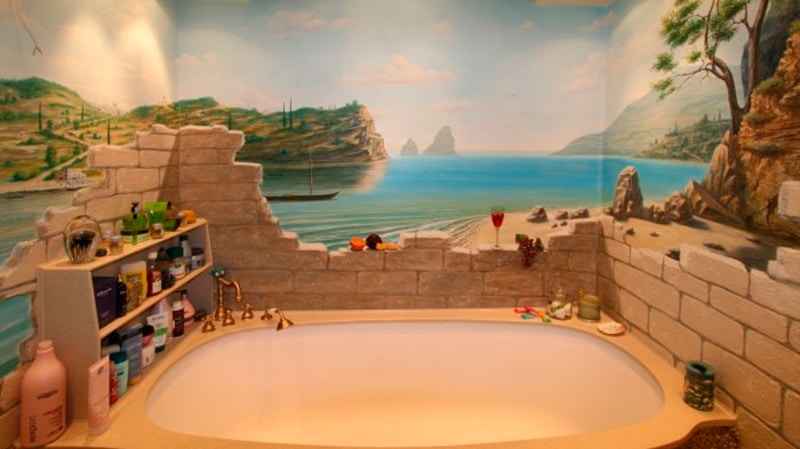
Wall decoration in the bathroom with wallpaper
Wallpaper for the room, as well as paint must meet certain standards for water resistance.
When choosing glue, pay attention to temperature conditionin which it is recommended to use it. Otherwise, you will get an ugly “bubble” on the wall or an “eternal” repair in your apartment, you will have to constantly glue or tint something.
Plastic is a relatively new trend in the construction industry. It is especially popular due to its unique properties. Lightweight, durable, durable and waterproof, provides good noise insulation in the room. Since it does not occur in nature, it becomes “tasteless” for various bacteria. The room in which the plastic is used has antibacterial properties. Fungus does not appear here and mold does not start, they simply have nothing to eat.
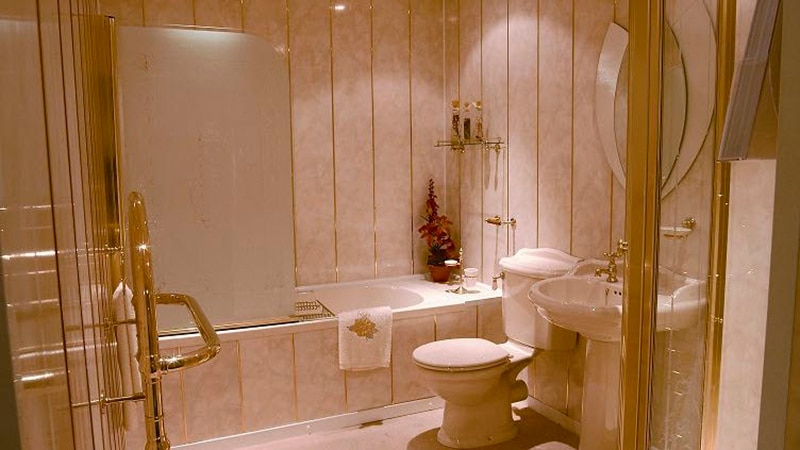
Wall decoration in the bathroom with wall panels
Wall panels made of polyvinyl chloride - easy to install, allow slight overload (can be mounted on inclined or curved surfaces). If the walls are even, they can be installed without an additional frame. Sometimes used as ceiling, in this case, the entire room is maintained in the same style.
If you are limited in the estimate or time of repair work, it is better to use material with a large area as a wall coating. A kind of "budget" option is a drywall coating, some models of which are designed for use in a humid environment.
The name itself suggests that the panels use gypsum, which is covered with sheets of cardboard with a protective coating. Given the fragility and intolerance to mechanical stresses, all work must be carried out with particular care and in accordance with a specific methodology.
This method allows you to quickly carry out all repairs, but requires special handling of the walls during operation. In particular, it is not recommended that vacuum handles or handrails be mounted directly on plasterboard. Provide additional mountings during installation. But with care, such walls will last a long time.
How did ancient people arrange their caves? You can turn to the origins and follow the path of ancestors who first decided to use natural stone in construction. But this does not mean that the bathroom will turn into a cave. This way is for those people who seek to create an individual interior, and modern materials are much more aesthetic than those that were used thousands of years ago.

Marble bathroom wall decoration
Depending on your preference, you can use:
This is a laborious and complex process, every part of the future wall is practically laid out anew. The glue or special mortar used for cladding must be used in accordance with the technology. The stone is difficult to process, and some areas will have to be sized. But as a result, you get a chic interior, no doubt worthy of its owner.
How to choose the right materials for wall decoration in the bathroom, so that the room is beautiful, safe and easy to clean? What can constantly withstand the effects of moisture, vapors, temperature changes and the aggressive effects of detergents? In this article we will consider 10 materials with which you can decorate your bathroom, as well as create a truly first-class atmosphere there.
Let's start with the classics! Most often, ceramic tiles are chosen for wall decoration in the bathroom. It is produced in a variety of forms, types and colors. It can be rectangular, square, hexagonal, glossy, matte, with texture or with a special decorative application. You can list the possible characteristics for a long time.
Manufacturers make every effort to satisfy any customer needs. For example, many people produce tiles in series. Thanks to this, you can choose the cladding for walls, floors and decorative elements from one set. It will all be made in one style, and all its colors will be perfectly combined with each other.
A combination of plain and color coatings may be an interesting design decision. For example, white with a patchwork pattern. Also, white or ceramic tiles combine Mediterranean or other authentic patterns that give the room a certain mood.
A combination of white and wood color will look very relevant. This direction has come to us from eco-design. This design removes the feeling of sterility that can occur in a pure white bathroom.
When choosing ceramic products, the mosaic deserves special attention. This is not the easiest styling material, but the result will be worth the effort. With these miniature tiles you can create a beautiful and sophisticated design for the shower area and sink. In addition, with the help of specially marked sets, you can depict small drawings or even full-fledged paintings in the bathroom.
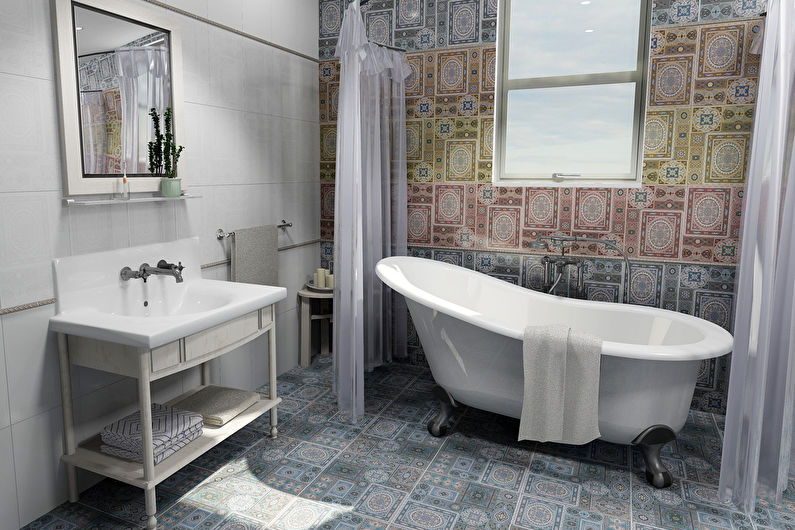

An equally popular method of wall decoration in the bathroom is painting. Usually it is recommended to use acrylic or semi-gloss aqueous emulsion ink from acrylic copolymer. When choosing, read the instructions on the package. Usually it contains a detailed description of the material indicating the degree of resistance to moisture, as well as detergents and cleaners.
Compared to various tiles, paint is a more affordable material. In addition, it is much easier to apply. Nevertheless, it should be borne in mind that such processing is still subject to some negative influence of humidity. Therefore, it is better to use it either in a combined combination with other finishing materials, or if the plumbing is located so that the walls will not have constant contact with water.

Due to the tendency to design interiors with natural materials, more and more often stone is used to decorate the walls in the bathroom. At the same time, natural material and its proper installation is a rather expensive pleasure that not every homeowner can afford.
As an alternative, manufacturers began to produce high-quality artificial substitute. Visually, it is very similar to natural raw materials. In addition, unlike real stone, artificial - has a very small weight and it is much easier to stack.
With regard to design, it is worth considering that an overabundance of such expressive materials can negatively affect the overall interior of the bathroom, especially if the room is small. It is better to decorate with stone only part of the room or several small areas. For example, you can make one contrasting wall or lay out a stone form for the bathroom and sink.
When combined, this type of finish is best combined with painting, plastering or ceramic tiles. But depending on your project, other options are possible.
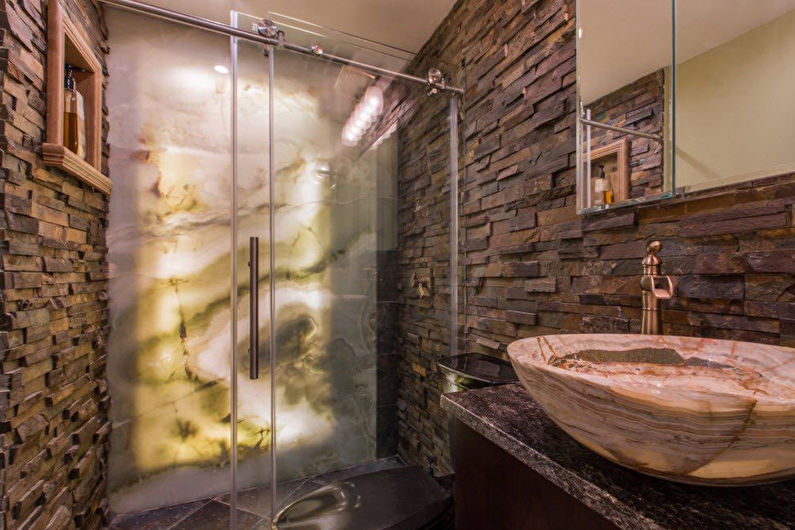

Like stone, wood has become more actively used for bathroom decor due to the trend towards natural materials. But in order to perform such wall decoration, the wood must first be carefully prepared using special means. You must be sure that the boards do not rot in a couple of years and you do not have to do repeated repairs.
The tree in the bathroom is most often used as a contrasting material for the design of one wall or some specific areas - the wash basin area, cabinets and others.
If you are not ready to use natural material, you can always choose an artificial option instead. It can completely recreate the appearance of a tree or just have a woody pattern.
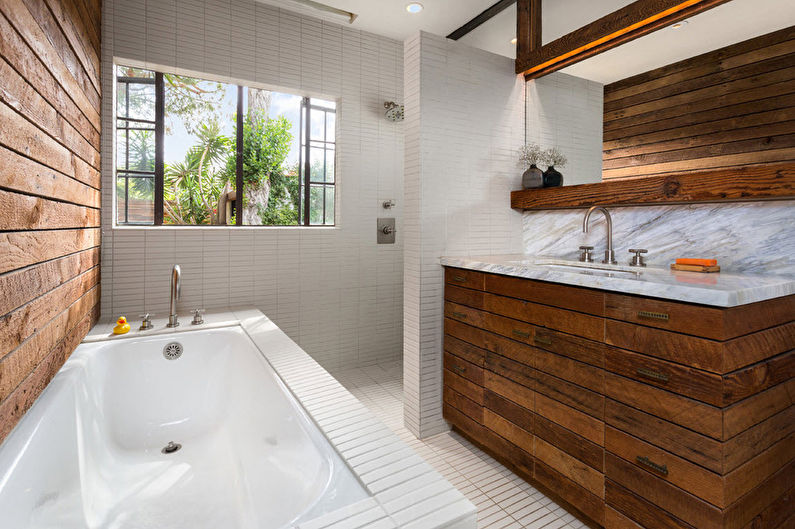

Another non-standard material for wall decoration in the bathroom is plaster. It can be applied if the bathtub is partially finished with tiles or other moisture-resistant material, as well as if the plumbing does not adhere to the walls.
In order to protect such a finish from negative factors, it must be covered with a special protective varnish or other means of a similar action.
Using decorative plaster, you can create a soft and pleasant design in the Scandinavian style. It can also be designed as a somewhat rough surface with a pronounced embossed texture - this option is perfect for decorating a bathroom in the loft style.

Originally not intended for wall decoration in the bathroom, the brick requires careful processing with protective and antiseptic agents.
It is advisable not to place this material in places of proximity with water. Rather, it should become just a design element - with its help you can decorate individual sections of the room, make contrasting walls in the room or design niches.
The slightly sloppy look that arises when using a brick is perfect for creating a Scandinavian and loft style. And when painted in white - you can get an interesting classic version, Provence or Shabby chic.

If you have a small bathroom and would like to visually enlarge it, then consider using a mirror tile. It is applied in the same way as ceramic, but you need to be a little more careful with it, since it is a more fragile material.
Of course, it makes no sense to make a completely mirror room - usually tiles are applied either in sections or only on one of the walls. You also need to understand that this type of design requires complex care - it is better to place such inserts where it is unlikely that they will get wet, otherwise you will have to constantly rub them.
When choosing a tile size, it is worth considering that large options can only be used in large bathrooms. They do not visually expand, but on the contrary, they will slightly conceal the space. For a small bathroom, medium or small size material is best. Mirror mosaics are also available. It can be used as an independent design element, as well as as part of ceramic or glass mosaic.


No matter how unexpected it may sound, wall decoration in the bathroom can also be done using wallpaper. You just need to choose those types that are well resistant to moisture - vinyl or acrylic.
In a small room on one of the walls you can glue wallpaper. Depending on the picture, they can give the room a certain stylistic effect. For example, a landscape will create a sense of perspective in the distance, bright flowers will cheer you up, and a warm pastel color pattern will add a sense of comfort.
But, despite the relative water resistance, when using wallpaper in the bathroom you should always remember - if the liquid gets to the junction of two paintings, then gradually they can begin to move away from the walls.

More recently, glass tile has become another popular material for walls in the bathroom. This is a fairly strong and safe coating, which is made of tempered glass. It perfectly withstands both cleaning with detergents, and any other types of aggressive effects.
Glass tiles are available in various sizes, from the smallest to the largest. It may have a different color or pattern. In addition, this material is available in the form of mosaics.
Since the glass finish is not afraid of moisture, it can be placed in any part of the bathroom, including in the shower area or near the bathtub where water flows.
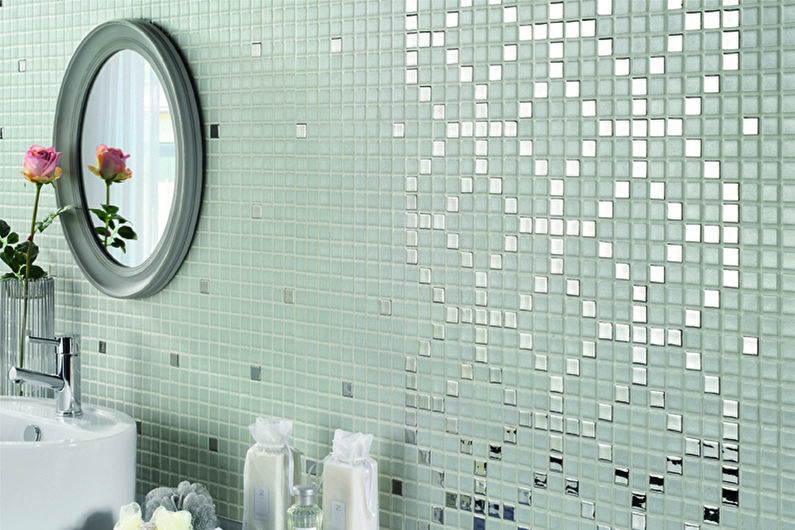
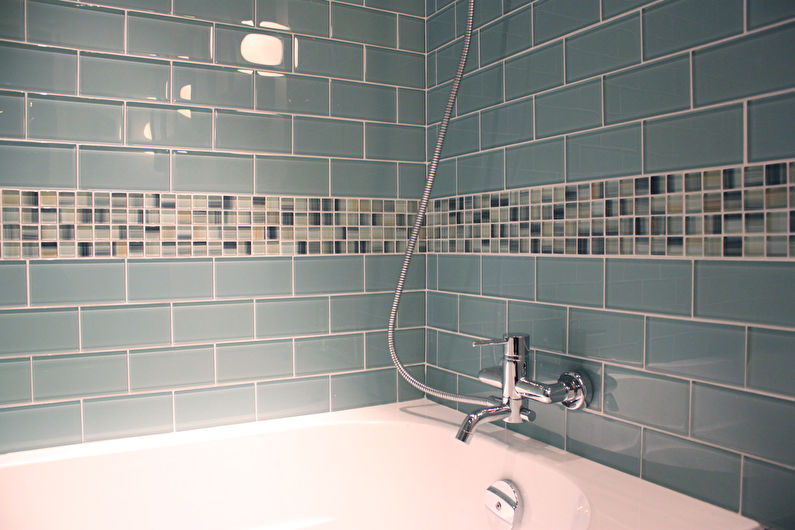
One of the most beautiful and expensive materials for decorating a bathroom is marble. In addition to its external attractiveness, it has a couple of features that are better prepared in advance. In the future, this will help to properly monitor its condition and maintain its natural beauty as long as possible.
The fact is that this stone can absorb in a small amount the substances that fall on it. This means that if you use some colored hygiene products and they get on the stove, indelible spots may appear on it. In addition, aggressive detergents can damage it.
In other words, marble is a “living” stone, which actively interacts with the substances surrounding it and can change under their influence.
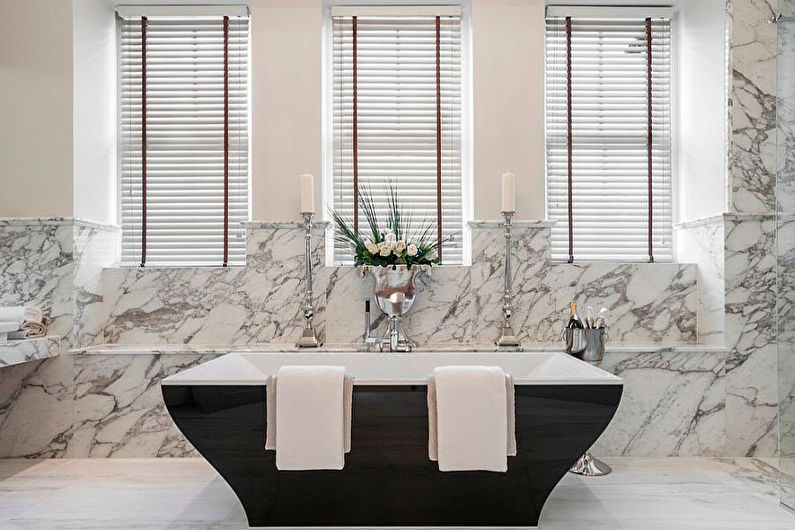

The bathroom is one of the most important in every home. The morning of any person begins with a visit to this particular small room. And in order for the day to start with a smile, everyone wants to make this place as beautiful and comfortable as possible. To help you decide on the choice of finishing material for the bathroom, in this article we will consider the most popular of them.
Today, materials for decoration are more than enough, but do not forget that the bathroom carries a rather large functional load.
That is why materials for finishing this room should have a number of properties:
Having examined all kinds of materials, we have chosen the most suitable of them:
Let's consider each of them in more detail.

Today, decorative ones are in great demand. Their main feature is the possibility of additional insulation of the room during installation. This is not a bad replacement for old tiles.
Key Benefits plastic panels:
Even in ancient times, mosaics were used to decorate palaces and temples. And today it is used quite widely.
This material has several advantages:
The main disadvantages of the mosaic:
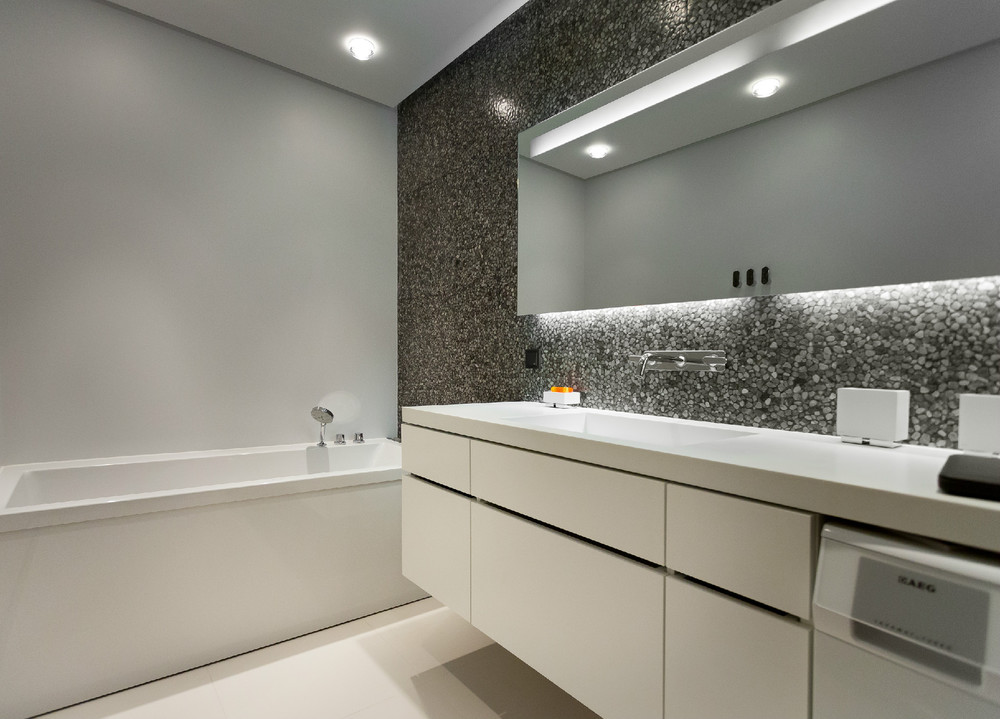
As the main finishing material, paint is used very rarely. Most often it is combined with other types of materials.
Despite this, she has some advantages:
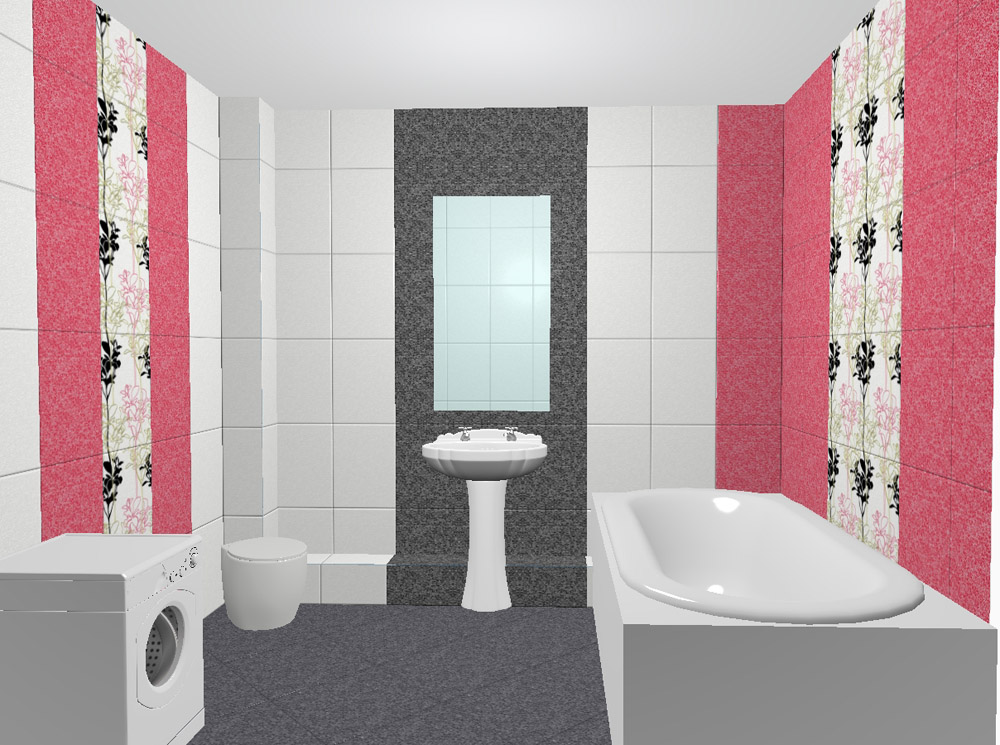
In our opinion is - ceramic tiles. Tile is the most common bathroom product.
And she gained such popularity due to her advantages:
Tip: it will be useful to treat the surface with a special waterproofing solution as the bathroom is a very humid room. Waterproofing will provide additional protection for tiles from moisture.

Note! Ceramic tiles can be cut in two ways: using a grinder and a winning circle or with a special cutter.

In this article, we examined the popular decoration materials for bathrooms, described their advantages and provided instructions for installing ceramic tiles. And in the video in this article there is still much useful on this topic!
Have a good repair!
- One of the most important and special places of any apartment, therefore, an approach to it needs a special one. Here, often the humidity is kept at a high level, and it won’t be so easy to weather, therefore, materials for its decoration should be chosen on the basis that the room temperature will be slightly higher than in others, and the accumulated moisture will sometimes even settle on the walls in quality of condensate and not only. Any material used must be durable and at the same time have good resistance to chemical detergents and cleaners. Fortunately, modern industry offers us a wide variety of materials for decorating the bathroom, but we have to choose the best from all this diversity.
The very first thing that comes to mind when mentioning the decoration of the walls of the bathroom. This material is virtually flawless in terms of durability and hygiene. It is also environmentally friendly and resists moisture. And in terms of cost, there are no problems. The range of prices is so wide that you can choose a tile based on your own capabilities. A win-win option for your wallet (with not the highest capabilities) - buying tiles of domestic production. However, if you do not want to save on tiles, material from Spain or Italy will be a great purchase. It is important to make a choice, and then nothing interferes with the transformation of the bathroom. You can do this yourself, but you need to know all the subtleties perfectly, this is a truly dusty process that takes a lot of time and energy. It is often easier, though not cheaper, to call a team of masters. This is an additional expense, but as a result, you can be sure. Often the bathroom is “finished” with natural marble, which has properties similar to ceramics.
This is one of the most common ways to decorate the walls of the bathroom, since the plastic panels have a low price and are easy to install. Plastic is not afraid of temperature changes and calmly refers to moisture and washing. In addition, the installation of plastic panels allows you to bypass such a difficult moment as the alignment of the walls. However, before you install plastic panels, you need to apply a water-repellent to the walls of the bathroom in order to avoid condensation in the cavities of the panels. True, you can avoid condensation even if you first install the crate, on which then install the panels. Plastic panels have a great variety of shades and textures, so choosing them to your taste is not a difficult task. And at a price the panels will cost less than ceramic tiles.
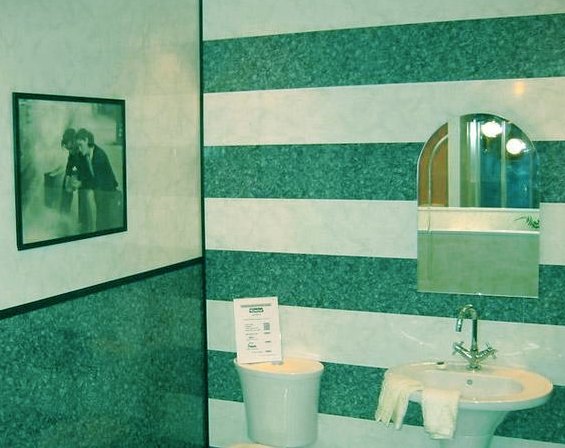
Another thing is that mold can form on the back of these plates. And light colors over time can acquire a yellowish tint, which will not affect the appearance of the room in the best way. Nevertheless, the choice of plastic panels is a fairly simple and reasonable solution from the point of view of economy and degree of complexity of decoration.
The times when the walls of the bathroom were painted were already a thing of the past. However, there are people who are adherents of this particular method of decoration. For such craftsmen, latex-based paint or waterborne paint can be recommended. Such paints calmly tolerate a high level of humidity and do not have the ability to quickly become contaminated. A big plus is that you can draw anything on the wall with it. Another thing is that paint can expose all the flaws and bumps of the wall. That is why before using it, the wall must be properly aligned.
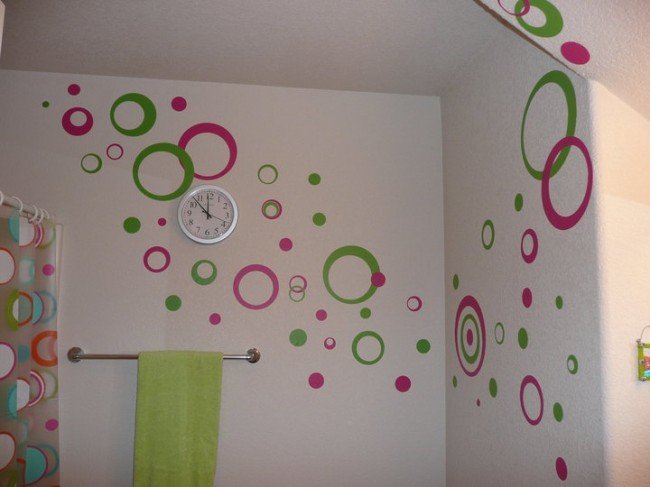
It would seem that they are doing in this article, because this is one of the most inappropriate materials for decoration. However, those who like to often and sometimes completely change the look of the bathroom will not agree with this. And this will be helped, first of all, by vinyl wallpapers, which are easy to wash, and which are not afraid of moisture. But they also have a weak point - these are the joints between the panels, where water will certainly fall and shorten the life of the material. But that is precisely why such material can be used by those who do not like to live in one setting for a long time. Before gluing vinyl wallpaper, the wall is leveled with a moisture-resistant primer, and waterproof glue is used for gluing.

A more reliable option in this case is fiberglass wallpaper. Before gluing this type of wallpaper, primer-glue is applied to the wall, then wallpaper is glued, and then another layer of this glue is applied, after which moisture-proof paint is used. This material is good in that it is quite economical, looks attractive and does not require a lot of time.
This material is only gaining popularity now, but it is still far from flourishing, since its prices are high, and only people with good income can allow a full finish of the bathroom with such material. In other cases, glass tiles are bought in addition to ceramic. It has a perfectly flat surface, and therefore is completely resistant to attack by bacteria and harmful microorganisms, which means it has a high degree of hygiene. The texture of this material may resemble ice and silver, and a tile with a holographic pattern allows you to see running water, such an effect is born in the eyes when viewing a holographic effect. In addition, glass tiles add extra volume to the bathroom. However, most often it is used as inserts, and in general, buyers are still not very well aware of it. For example, there is a tile made of Bohemian glass, which is also called “living tile”. The Czech company Treseburg makes such tiles, offering a large number of shapes to choose from.

With the help of mosaics, you can create something incredible in your bathroom, which will help an incredible amount of colors of this material. However, to fit a piece to a piece, you have to sweat a lot. The work of decorating the bathroom with mosaics is very painstaking and requires a professional approach. And this type of work is much more expensive than working with ceramic tiles. Mosaic is divided into two categories - economy class and elite mosaic.
A bathroom is a rather specific room, which carries a considerable functional load. It is here that we wash, wash, wash something, take a bath or shower, etc. Obviously, the materials used to decorate this room must meet a number of requirements. Firstly, differ in a high degree of moisture resistance. It is no secret that during the operation of the bathroom moisture gets on the floor, walls and even the ceiling.
With insufficient moisture resistance of the finishing materials, the room will quickly take on not the most attractive appearance, and you will have to regularly spend money on new repairs.
Secondly, the finish must withstand the effects of aggressive environments, in particular when using various household cleaners. Thirdly, an indispensable requirement for materials for interior design is their washing and cleaning. Fourth, their resistance to corrosion processes, as well as the formation of fungi and mold, the reproduction of which adversely affects human health, is mandatory.
Today, the choice of finishing materials for the walls of the bathroom is extremely large, despite the many requirements for them. Modern technologies and special impregnations allow even wood to be used in the interior design of this room. With proper and timely care for it, you can cast aside all doubts and fears about its swelling, deformation and loss of a pristine aesthetic appearance. So, most often the consumer is faced with a choice between the following finishing materials for the walls:
Each material has its own advantages and disadvantages, which should be taken into account. The most common when decorating walls was ceramic tile, as it is beautiful, easy to use and does not create problems in maintenance. Moreover, its cost varies widely, and you can easily select tiles for your wallet. Received no less popularity bathroom finish Pvc panels , since they are not afraid of moisture and easily tolerate even sudden changes in temperature. However, it is worth considering that the inside of the plastic eventually molds, and the white panels turn yellow.
Painting the walls of the bathroom is an old, proven over the years method of designing them. Water-dispersion and latex paints will provide a reliable, moisture-resistant and durable coating, thanks to which on the walls of the room you can depict anything that your heart desires. It should be borne in mind that the paint will not hide all the roughnesses and flaws of the walls.
Stone is often used in the design of walls in the bathroom, but we must not forget about its considerable weight. For instance, thin walls "Khrushchev" can not withstand such beauty. Specialists recommend using this material in combination with others to create certain accents, for example, with wood. Metal is much less common in the interior of this room, however, the corresponding inserts for wall decoration are widely used in high-tech style. Of course, metal elements must have a corrosion-resistant coating.
Original and surprisingly beautiful material is glass tilecharacterized by excellent operational characteristics. Glass not only visually expands the space, but also allows you to create a number of different effects: for example, a coating with a holographic pattern can simulate water running down the wall. Thus, you have plenty to choose from, funds would allow.
The bathroom floor should be given special attention. Looking at the walls, we evaluate, first of all, the attractiveness of the design and originality of the design, and only then we think about the durability of the material and its other properties. Of course, the floor should also be beautiful, but it is necessary to approach its upholstery, guided in the first place by security considerations. In the bathroom, it should be not only traditionally moisture resistant, but also non-slip. You should confidently lower your wet feet on it, leaving the bath, and not be afraid to fall.
The most common material for flooring in this room today is ceramic tile. Wide color gamut, moisture resistance, durability and safety - all this makes it very popular. Is it possible to replace it with something? Of course you can, but you will have to be prepared for the fact that this alternative will be more problematic in maintenance and operation.
Instead of ceramic or porcelain, for example, artificial stone can be used to interior decoration. However, it is worth paying attention to the fact that it must be artificial, since a natural analogue is often distinguished by fragility, great weight and the ability to become slippery at the slightest wetting.
The budget option is linoleum flooring, but here there are some nuances. Firstly, the use of this coating will require you to install additional floor insulation. Secondly, most likely, you will have to acquire special rubber foot mats, since even the most expensive linoleum becomes slippery when wet. Thirdly, the lack of a carefully prepared base for this material and the non-observance of the rules for its operation often lead to the formation of mold on its surface.
Pretty rare, but still found in the bathroom flooring from wood. As a rule, this is a laminate, parquet or floorboard. However, they are suitable for finishing the floor in a room with high humidity only under the condition of high-quality processing with special protective compounds. Valuable wood, impregnation and several layers of varnish - all this can make the wooden floor in the bathroom quite durable. Experts recommend purchasing material from the following wood species:
The most common solution when decorating a ceiling in a bathroom is to pre-align, putty, prime and paint it. This option is considered quite budgetary and practical. Waterproof paint is able to withstand the onslaught of vapors, splashes, as well as high temperatures, and, in addition, it is presented in a wide range of colors.
However, today suspension, tension, rack structures are gaining more and more popularity. Each of them has its advantages over traditional dyeing. So, the suspension design allows you to mask the wiring and other communications, to avoid the additional cost of leveling the ceiling surface. Its main disadvantage is a decrease in the height of the room by about 10-15 cm.
A perfect solution would be a rack ceiling made of aluminum elements. It is not only fairly easy to install, but also extremely easy to maintain. In addition, the rack aluminum ceiling is absolutely not afraid of moisture even in a poorly ventilated bathroom and does not rust over time. The wide range of colors of the slats allows you to realize the most unusual design ideas.
Increasingly, the bathroom is decorated with stretch ceilings - a fabric or PVC cloth stretched over the frame. Such designs allow you to mount point lighting in them, which looks pretty advantageous in the bathroom. However, it is worth considering that PVC film does not like low temperatures too much.
Obviously, the choice of materials for decorating the bathroom is very wide, the possibilities of decorating the room that they provide are even more enormous. That is why it is so important to make the right choice, because your bathroom should always be comfortable and cozy.